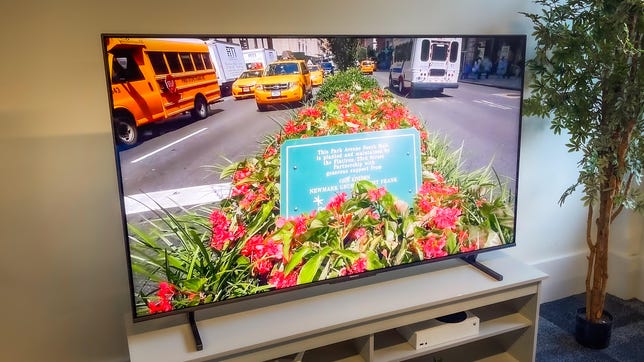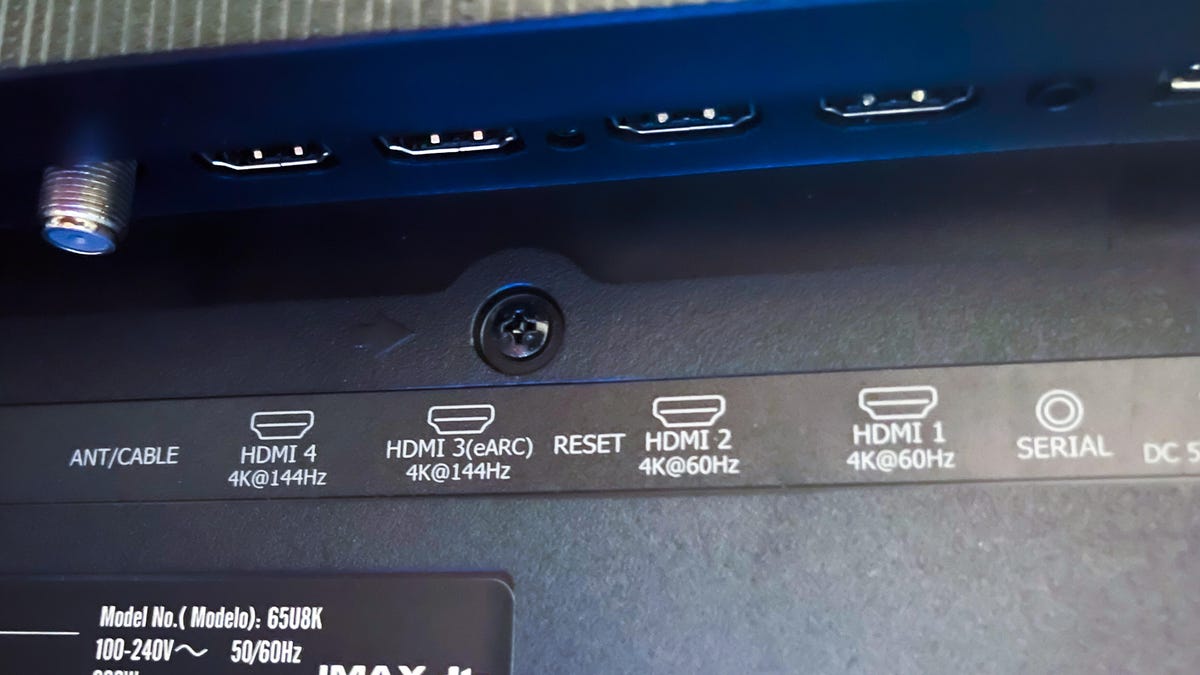
8.8
Hisense U8K series (2023)
Like
- Relatively affordable
- Excellent overall image quality
- Capable Google TV system
- Offers a 55-inch screen size
Don’t like
- Not quite as bright or dynamic as some competitors
- “Theater” picture modes engage motion smoothing by default
The main competition for the Hisense U8K is the TCL QM8 series. Both are currently available for around the same price, both have negligible brand cachet, both use the Google TV smart system and both offer mini-LED with spectacular pictures. I compared them side by side in the TV lab at CNET and I’m confident either one would make a picture quality snob (like me) happy.
The Hisense has one medium-sized advantage: a 55-inch screen option. The smallest TCL QM8, meanwhile, is 65 inches. So if 65 is too large for your room, your budget or your tastes, the choice between the two is simple: get the 55-inch Hisense UK8. Or bite the bullet and get a bigger TV.
If you do want a 65-inch or larger TV I’d recommend the TCL by a hair, assuming their prices are close. Its picture looked brighter and more impressive overall than the Hisense, although the TCL wasn’t without flaws. That said, if that price gap grows a lot bigger, I wouldn’t blame you for saving the money and going with the U8K. It’s an excellent TV and you’d have to step way up to an OLED TV to get a significant boost in image quality.
Hisense U8K series TV sizes
I performed a hands-on evaluation of the 65-inch Hisense U8K, but this review also applies to the other screen sizes in the series. All sizes have similar specs and should provide similar picture quality. The exception is the 75-inch size, which uses a different panel type (ADS), which can lead to worse black-level performance than VA panels used on the other sizes. I can’t say for sure however since I didn’t test that size.
The U8K sits near the top of Hisense’s 2023 TVs lineup. The company does make more-expensive models – a souped-up 85-inch ULED X that costs $3,800 and ultrashort throw laser projectors (“Laser TV” according to Hisense) that start at $5,000 for 100 inches – but the U8K is the model most TV shoppers will be looking at. The company’s less-expensive U7K and U6K TV series also offer mini-LED backlights but have fewer local dimming zones and aren’t as bright as the U8K. I haven’t reviewed them but based on their specifications I expect their image quality will be worse than that of the U8K.
And if you happen to be in the market for a 100(ish)-inch TV, it’s worth noting that the 98-inch TCL QM8 costs more than $10,000 at the time of this writing while the 100-inch Hisense U8K costs less than half as much. Advantage: Hisense.
Hisense U8K design and remote: Basic, and that’s fine
The Hisense U8K is a humdrum-looking TV, and that’s OK in my book. It’s supported by a pair of squared-off legs to either side under the main panel. It’s also quite heavy, as befits a model with such a complex backlight.
The standard black, rubber-buttoned clicker sports two different menu buttons (one gear-shaped and another “hamburger”), a dedicated profile key for some reason and no fewer than six shortcut keys to streaming services – the usual suspects and, for some reason, Tubi. Another button summons Google Assistant, which you can talk to via remote. You can also invoke the Assistant by saying “OK Google” into thin air, thanks to the U8H’s built-in far-field mic.


Note that this image has been flipped 90 degrees clockwise so the labels are more legible. On the back of the TV, the inputs are arranged vertically and face the side.
The U8K can accept 4K/120Hz input signals from an from an Xbox Series X or a PlayStation 5. Like many newer TVs those inputs technically go up to 144Hz, but that’s not a big deal in my opinion since since you need a PC gaming card to take advantage of it and likely won’t provide a big boost over 120Hz input. Other gaming extras are par for the midrange TV course, namely VRR, or variable refresh rate, and ALLM (auto game mode). One of the inputs also supports eARC.
The U8K’s antenna input has a built-in ATSC 3.0 over-the-air tuner, which allows it to receive NextGen TV broadcasts. Those are still only available in a small number of markets so I didn’t get the chance to check out this feature, but it’s nice to know that if the broadcasts become more widespread, U8K owners won’t have to connect an external tuner box to watch.
Hisense U8K vs. TCL QM8 and others: Picture quality compared
For this comparison I lined up three 65-inch TVs side by side: the Hisense UK8 and the TCL QM8, which cost about the same, and the LG OLED C3, which costs significantly more. I didn’t include other models in the lineup this time but from past reviews I can say the image quality of the U8K is significantly better – brighter, with better color and contrast – than the Roku TV Plus Series, Amazon’s Fire TV Omni QLED and Vizio MQX (all of which cost less) and about the same as last year’s TCL 6-Series and Hisense U8H.
TV and movies: I started my evaluations, as usual, with the demo montage from the Spears & Munsil 4K Blu-ray disc, and its nature scenes looked excellent. The well-lit shots of Yellowstone geysers and mountains were bright and brilliant, albeit a notch less impressive than the brighter TCL QM8 and not quite as contrasty as the LG OLED C3.
The difficult black background shots also looked tremendous, with almost no blooming and just a touch lighter than the absolute black I saw on the C3. The range of color and brightness looked a bit more natural on the Hisense than on the TCL, but the latter again showed an advantage in brightness.
Watching the Netflix series Our Universe, I was similarly impressed by the Hisense. In a series of animations of galaxies and star fields, for example (ep 2, 32:18), it maintained deep black levels in the letterbox bars and large swaths of void better than the TCL 6 series, albeit not quite as well as the TCL QM8 or (of course) the OLED. Highlights in a flare (33:35) were much brighter than on the OLED and 6 series, however, although again a bit dimmer than the QM8.
And when the action returned to the rainforest, the Hisense delivered excellent contrast and color in the forest canopy and plenty of detail in the fur of the chimps. Once more it lagged behind the TCL QM8 in brightness and contrast but the difference wasn’t huge. And I did think the Hisense looked a bit more natural overall than the QM8, which subjectively seemed just a bit too bright in highlights.

